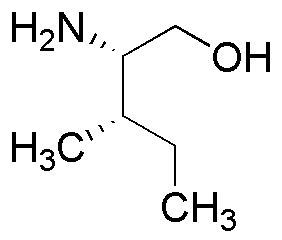L-Isoleucinol is widely utilized in research focused on
- Pharmaceutical Development: This compound serves as a key intermediate in synthesizing various pharmaceuticals, particularly those targeting metabolic disorders, enhancing drug efficacy and specificity.
- Biochemical Research: L-Isoleucinol is used in studies related to amino acid metabolism, helping researchers understand its role in protein synthesis and cellular function.
- Food Industry: It acts as a flavor enhancer and nutritional supplement, providing essential amino acids that can improve the nutritional profile of food products.
- Cosmetic Formulations: The compound is incorporated into skincare products for its moisturizing properties, promoting healthier skin by retaining moisture and improving texture.
- Animal Nutrition: L-Isoleucinol is added to animal feed to boost growth and improve overall health, ensuring livestock receive adequate nutrition for optimal performance.
General Information
Properties
Safety and Regulations
Applications
L-Isoleucinol is widely utilized in research focused on
- Pharmaceutical Development: This compound serves as a key intermediate in synthesizing various pharmaceuticals, particularly those targeting metabolic disorders, enhancing drug efficacy and specificity.
- Biochemical Research: L-Isoleucinol is used in studies related to amino acid metabolism, helping researchers understand its role in protein synthesis and cellular function.
- Food Industry: It acts as a flavor enhancer and nutritional supplement, providing essential amino acids that can improve the nutritional profile of food products.
- Cosmetic Formulations: The compound is incorporated into skincare products for its moisturizing properties, promoting healthier skin by retaining moisture and improving texture.
- Animal Nutrition: L-Isoleucinol is added to animal feed to boost growth and improve overall health, ensuring livestock receive adequate nutrition for optimal performance.
Documents
Safety Data Sheets (SDS)
The SDS provides comprehensive safety information on handling, storage, and disposal of the product.
Product Specification (PS)
The PS provides a comprehensive breakdown of the product’s properties, including chemical composition, physical state, purity, and storage requirements. It also details acceptable quality ranges and the product's intended applications.
Certificates of Analysis (COA)
Search for Certificates of Analysis (COA) by entering the products Lot Number. Lot and Batch Numbers can be found on a product’s label following the words ‘Lot’ or ‘Batch’.
*Catalog Number
*Lot Number
Certificates Of Origin (COO)
This COO confirms the country where the product was manufactured, and also details the materials and components used in it and whether it is derived from natural, synthetic, or other specific sources. This certificate may be required for customs, trade, and regulatory compliance.
*Catalog Number
*Lot Number
Safety Data Sheets (SDS)
The SDS provides comprehensive safety information on handling, storage, and disposal of the product.
DownloadProduct Specification (PS)
The PS provides a comprehensive breakdown of the product’s properties, including chemical composition, physical state, purity, and storage requirements. It also details acceptable quality ranges and the product's intended applications.
DownloadCertificates of Analysis (COA)
Search for Certificates of Analysis (COA) by entering the products Lot Number. Lot and Batch Numbers can be found on a product’s label following the words ‘Lot’ or ‘Batch’.
*Catalog Number
*Lot Number
Certificates Of Origin (COO)
This COO confirms the country where the product was manufactured, and also details the materials and components used in it and whether it is derived from natural, synthetic, or other specific sources. This certificate may be required for customs, trade, and regulatory compliance.


